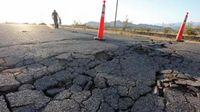On Sunday, April 13, 2025, a series of earthquakes rattled several regions across Asia, including India, Myanmar, and Tajikistan, prompting fears among residents and raising concerns about the ongoing seismic activity in the region. The tremors, which occurred in a span of just one hour, served as a stark reminder of the tectonic volatility that characterizes this part of the world.
The first quake struck at 9:00 AM local time in Mandi district, Himachal Pradesh, India, registering a magnitude of 3.4. According to the National Center for Seismology (NCS), the tremor originated at a shallow depth of 5 kilometers, making it more perceptible to residents. Despite the quake being classified as minor, many locals reported feeling a low rumble followed by a sudden shake, causing them to rush out of their homes and offices in alarm. Fortunately, initial reports indicated no injuries or property damage.
Just minutes later, at approximately 9:54 AM, a more powerful 6.1 magnitude earthquake struck the border region of Tajikistan. The epicenter was located at a depth of 10 kilometers, and it was felt strongly in surrounding areas. This quake was initially reported as a magnitude of 6.4 but was later revised to 6.1 by the European Mediterranean Seismological Centre (EMSC). Residents in nearby towns experienced significant shaking, leading to evacuations of schools and shops as a precautionary measure. Fortunately, there were no immediate reports of casualties or damage.
At 10:36 AM, another tremor of 3.9 magnitude hit Tajikistan, again at a depth of 10 kilometers. This sequence of events has heightened anxiety among residents who are still recovering from the earlier tremors.
Meanwhile, in Myanmar, a 5.5 magnitude earthquake struck near Meiktila shortly after the quakes in India and Tajikistan. This tremor was one of the strongest aftershocks following the devastating 7.7 magnitude earthquake that occurred on March 28, 2025, which claimed the lives of over 3,600 people and left thousands injured. The latest quake was felt in both Mandalay and Naypyitaw, cities that are still grappling with the aftermath of last month's disaster. A resident from Wundwin reported that the quake was strong enough to cause panic, with people rushing out of buildings.
As of the latest updates, no new casualties or significant damage have been reported in Myanmar following the 5.5 magnitude quake. However, the ongoing seismic activity has intensified anxiety among the population, many of whom are still mourning the losses from the March earthquake.
According to reports from the Thai Meteorological Department, as of Saturday, April 12, 2025, a total of 468 aftershocks had been recorded in Myanmar and surrounding areas, following the catastrophic March earthquake. These aftershocks included 184 with magnitudes between 1.0 and 2.9, 198 with magnitudes between 3.0 and 3.9, 73 with magnitudes between 4.0 and 4.9, and 13 with magnitudes between 5.0 and 5.9.
The tremors on April 13 not only affected India and Myanmar but also highlighted the ongoing seismic threats faced by Tajikistan. The country has been no stranger to earthquakes, and the recent seismic activity has raised concerns about the potential for further quakes in the region. The depth of the earthquakes plays a crucial role in how they are felt on the surface, with shallower quakes generally causing more intense shaking.
In response to the devastating effects of the March earthquake, humanitarian efforts are ongoing in Myanmar. The Indian government has shown solidarity by sending a specialist team of engineers under Operation Brahma to assist with relief operations. This team arrived in Myanmar on April 6, 2025, and has been involved in providing aid to affected communities.
As the region continues to experience seismic activity, experts urge residents to remain vigilant and prepared for potential aftershocks. The recent quakes serve as a reminder of the importance of disaster preparedness in a region that is prone to such natural disasters.
The tremors felt across India, Myanmar, and Tajikistan on April 13 have raised alarms and highlighted the need for continued monitoring and preparedness in the face of ongoing seismic threats. As the affected regions work to recover and rebuild, the international community's support remains crucial in addressing the humanitarian needs arising from these natural disasters.





